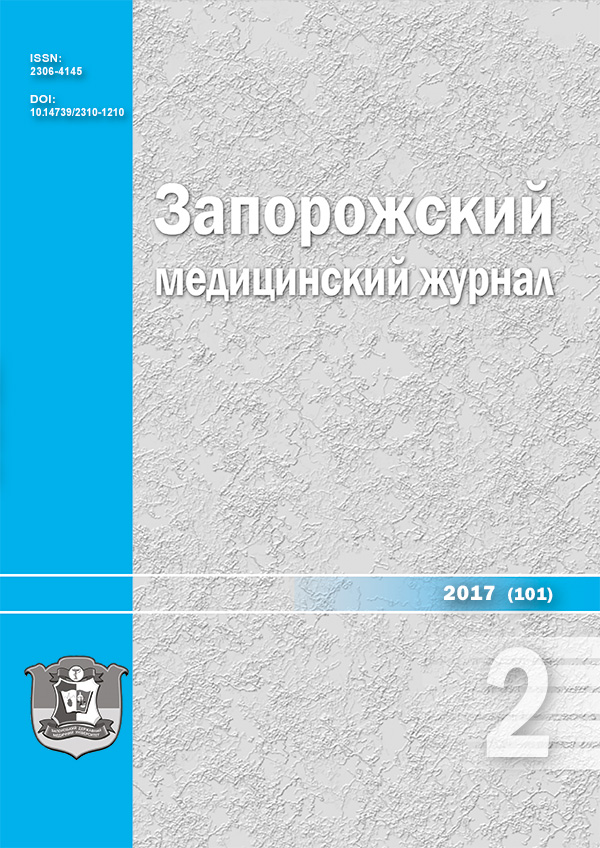Clinical and demographic characteristics of patients with nosocomial pneumonia against a background of severe traumatic brain injury
DOI:
https://doi.org/10.14739/2310-1210.2017.2.95674Keywords:
nosocomial infections, traumatic brain injury, TBIAbstract
Introduction. Nosocomial pneumonia (NP) is one of the most dangerous infectious complications of severe traumatic brain injury (TBI). According to some researchers, NP formed 0.5–1 % of hospitalized patients and in patients of ICU – NP develops with a frequency from 15 to 65 %.
The aim of our study was to determine the clinical and demographic characteristics of patients with NP, developed on the background of severe TBI.
Materials and Methods. 166 patients had been examined, including 58 patients with isolated severe head injury (group 1) and 108 patients with traumatic brain injury, which were complicated by the development of NP (group 2).
Results. Out of the first group patients 50 (86.2 %) were men, 8 (13.8 %) were women. The average age of patients in this group was 49.2 ± 15.2 years. Out of the first group patients 89 (82.4 %) were men, 19 (17.6 %) were women. The average age of patients in this group was 48.2 ± 16.7 years. The average length of in-patient treatment was 14.1 ± 6.2 days in patients of the 1st group versus 38.7 ± 17.6 days in patients of the 2nd group. In the 1st group 41 (70.7 %) were non-smokers, 10 (17.2 %) smokers 10 cigarettes per day, 10 to 20 cigarettes per day – 3 (5.2 %), more than 20 cigarettes per day – 4 (6.9 %). In the 2nd group 40 (37.0 %) were non-smokers, 33 (30.6 %) smokers 10 cigarettes per day, 10 to 20 cigarettes per day – 16 persons (14.8 %), more than 20 cigarettes per day – 19 (17.6 %).
Conclusions. In demographic structure of the NP, developed on the background by TBI, young men were dominated. The mean duration of hospital treatment of patients with NP increased 2.7 times compared with the patients with TBI uncomplicated by NP. Most patients of both the 1st and the 2nd groups were overweight (more than 50 % of patients). There is a significant percentage of the unemployed. A larger percentage of people who consume alcohol in the 2nd group of patients could be indicative of their poor social adaptation and difficult social conditions. Significantly greater number of smokers among the patients of the 2nd group confirms the importance of smoking as a risk factor of the NP development on the background of TBI.
References
American Thoracic Society (2005) Guidelines for the management of adults with hospital-acquired, ventilator-associated, and healthcare-associated pneumonia. American Journal Respiratory Critical Care Medicine, 171, 388–416. doi: 10.1164/rccm.200405-644ST.
Chuchalin, A. G., Sinopal´nikov, A. I., Strachunkij, L. S., et al. (2005). Nozokomial'naya pnevmoniya u vzroslykh: prakticheskie rekomendacii po diagnostike, lecheniyu i profilaktike [Nosocomial pneumonia in adults: practical recommendations for diagnosis, treatment and prevention]. Klinicheskaja Mikrobiologija i Antimikrobnaja Himioterapija, 7, 4–31. [in Russian].
Barbier, F., Andremont, А., Wolff, М., & Bouadma L. (2013). Hospital-acquired pneumonia and ventilator-associated pneumonia: recent advances in epidemiology and management. Opinion in Pulmonary Medicine, 19(3), 16–28. doi: 10.1097/MCP.0b013e32835f27be.
Dalhoff, K., Ewig, S., Abele-Horn, M., Andreas, S., Bauer, T. T., von Baum, H., et al. (2013). Adult Patients With Nosocomial Pneumonia: Epidemiology, Diagnosis, and Treatment Dtsch. Arztebl. Int., 110(38), 634–640. doi: 10.3238/arztebl.2013.0634.
Sopena, N., Heras, E., Casas, I., Bechini, J., Guasch, I., Pedro-Botet, M. L., et al. (2014). Risk factors for hospital-acquired pneumonia outside the intensive care unit: a case-control study. American Journal of Infection Control, 42(1), 38–42. doi: 10.1016/j.ajic.2013.06.021.
Feshchenko, Yu. I., Golubovska, O. A., Goncharov, K. A., Dziublyk, O. Ya., Dziublyk, Ya. O., Dmytrychenko, V. V., et al. (2013). Nehospitalna pnevmoniia u doroslykh osib: etiolohiia, patohenez, klasyfikatsiia, diahnostyka, antybakterialna terapiia ( proekt klinichnykh nastanov) Chastyna II [Community-acquired pneumonia in adults: etiology, pathogenesis, classification, diagnostics, antibacterial therapy (draft clinical guidelines) Part 2]. Ukrainskyi pulmonolohichnyi zhurnal, 1, 5–21. [in Ukrainian].
Corral, L., Javierre, C. F., Ventura, J. L., Marcos, P., Herrero, J. I., & Mañez, R. (2012) Impact of non-neurological complications in severe traumatic brain injury outcome. Critical Care, 16(1), 44–52. doi: 10.1186/cc11243.
Downloads
How to Cite
Issue
Section
License
Authors who publish with this journal agree to the following terms:- Authors retain copyright and grant the journal right of first publication with the work simultaneously licensed under a Creative Commons Attribution License that allows others to share the work with an acknowledgement of the work's authorship and initial publication in this journal.

- Authors are able to enter into separate, additional contractual arrangements for the non-exclusive distribution of the journal's published version of the work (e.g., post it to an institutional repository or publish it in a book), with an acknowledgement of its initial publication in this journal.
- Authors are permitted and encouraged to post their work online (e.g., in institutional repositories or on their website) prior to and during the submission process, as it can lead to productive exchanges, as well as earlier and greater citation of published work (See The Effect of Open Access)

